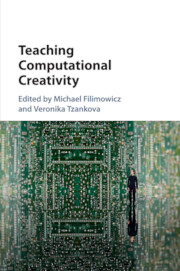Book contents
- Teaching Computational Creativity
- Teaching Computational Creativity
- Copyright page
- Contents
- Figures
- Tables
- Notes on Contributors
- Acknowledgments
- Introduction: Pedagogies at the Intersection of Disciplines
- PART I NEW FOUNDATIONS
- PART II CODE AS MEDIUM
- PART III PHYSICAL{LY} COMPUTING
- PART IV ONLINE LEARNING
- PART V CRITICAL PEDAGOGY
- PART VI TRANSDISCIPLINARY
- Interviews
- Afterword: Toward a Curricular Synthesis
- Index
- References
PART IV - ONLINE LEARNING
Published online by Cambridge University Press: 04 July 2017
- Teaching Computational Creativity
- Teaching Computational Creativity
- Copyright page
- Contents
- Figures
- Tables
- Notes on Contributors
- Acknowledgments
- Introduction: Pedagogies at the Intersection of Disciplines
- PART I NEW FOUNDATIONS
- PART II CODE AS MEDIUM
- PART III PHYSICAL{LY} COMPUTING
- PART IV ONLINE LEARNING
- PART V CRITICAL PEDAGOGY
- PART VI TRANSDISCIPLINARY
- Interviews
- Afterword: Toward a Curricular Synthesis
- Index
- References
Summary
An autoethnographic exploration of online code learning environments is situated within a context of multimedia cognition frameworks. This suggests new strategies for both the design of multimedia code learning content and facilities. What emerges from this analysis is the notion of a “three-screen scene” that articulates the spatially distributed cognitive tasks of programming workspace, note taking, and expanded context. The three-screen scene is considered as its own design frame for the development of both courseware and computer labs for self-learning coding skills.
- Type
- Chapter
- Information
- Teaching Computational Creativity , pp. 161 - 210Publisher: Cambridge University PressPrint publication year: 2017

